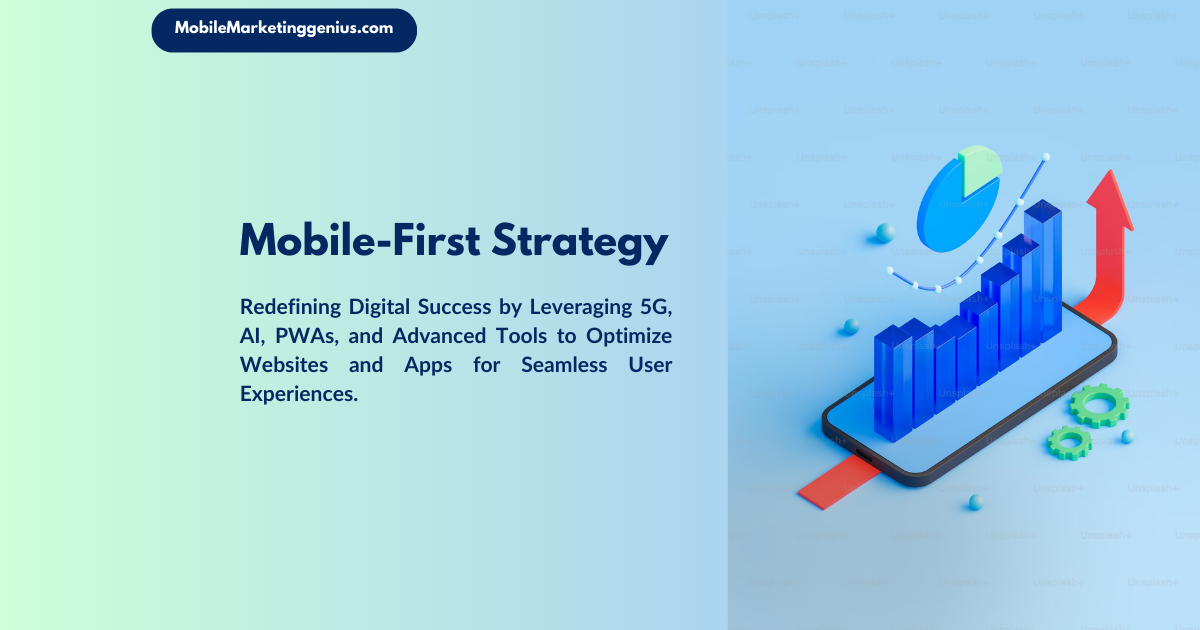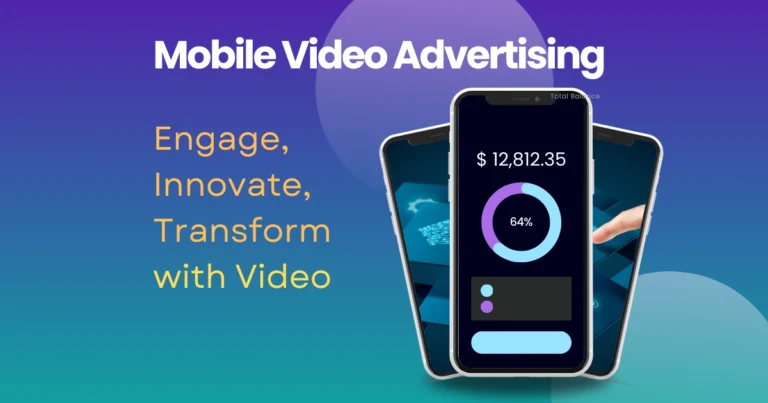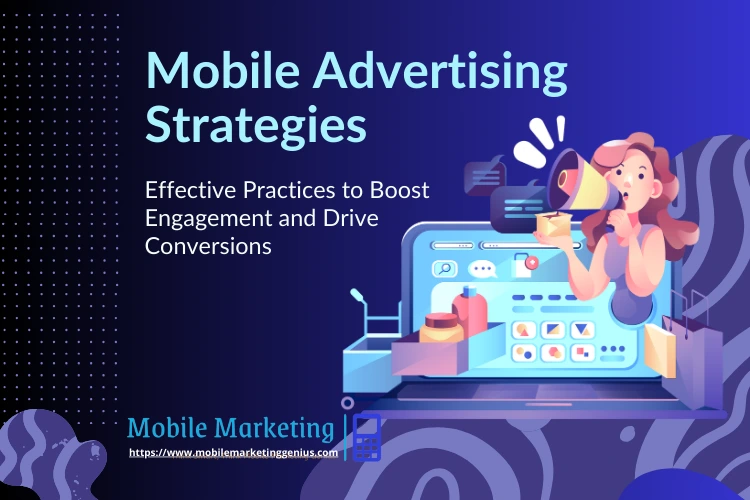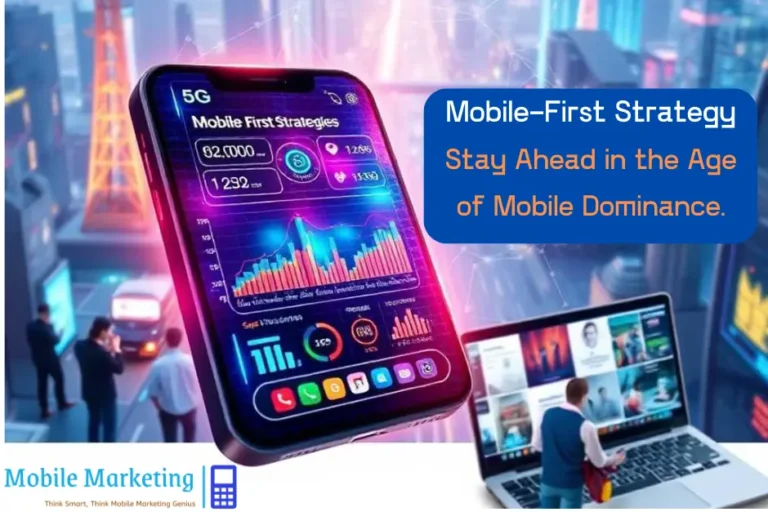Mastering the Mobile-First Strategy: A Complete Guide for Modern Marketers

The world has witnessed a significant shift in how people access the internet, with mobile devices taking center stage. This shift has made the Mobile-First Strategy a critical aspect of modern marketing and web development. A mobile-first strategy involves designing and optimizing digital experiences, such as websites and apps, for mobile devices before scaling them for larger screens like desktops or tablets.
This strategy is not just a trend but a necessity. With mobile devices accounting for over 50% of global web traffic, failing to prioritize mobile can lead to lost opportunities, lower engagement, and diminished search rankings. Businesses that embrace this approach often experience increased customer satisfaction, better brand perception, and a competitive edge in their industries.
In this article, we’ll dive deep into what a mobile-first strategy entails, its importance, implementation steps, challenges, and future trends. Whether you’re a marketer, developer, or business owner, this comprehensive guide will equip you with the knowledge to master the mobile-first approach.
Table of Contents
What is a Mobile-First Strategy?
Definition of Mobile-First Strategy
The Mobile-First Strategy is a design philosophy and development approach that prioritizes mobile devices when creating digital content. Unlike the traditional desktop-first approach, where designs are scaled down for smaller screens, mobile-first designs start with the smallest screen and scale up.
This approach ensures that mobile users—who form the majority of internet traffic—receive an optimized experience. It involves responsive design, fast-loading pages, touch-friendly navigation, and mobile-optimized content.
The Evolution of Mobile-First
The mobile-first concept emerged as smartphones gained dominance in the mid-2000s. Initially, websites were designed for desktops, with mobile versions often as an afterthought. However, with the rise of mobile-first indexing by Google and increased consumer expectations, businesses began shifting toward prioritizing mobile.
How Mobile-First Differs from Desktop-First
- Desktop-First: Designs are created for larger screens and adjusted for smaller ones. This often results in clunky mobile experiences.
- Mobile-First: Designs are created for mobile devices first, ensuring seamless usability on smaller screens. Desktop versions are then enhanced with additional features.
By focusing on mobile-first, businesses can deliver faster, more engaging, and user-friendly experiences.
Importance of Mobile-First Strategy
The Dominance of Mobile Usage
Mobile internet usage surpassed desktop years ago and continues to grow. According to recent studies, over 60% of global internet traffic now comes from mobile devices. Ignoring this trend means alienating a significant portion of your audience.
Impact on SEO and Search Rankings
Google’s mobile-first indexing means the search engine primarily uses the mobile version of a website’s content for ranking and indexing. Websites that are not mobile-friendly risk lower rankings, reduced visibility, and decreased traffic.
Enhancing User Experience
Users expect fast, intuitive, and visually appealing mobile experiences. A mobile-first strategy ensures websites and apps meet these expectations, leading to higher engagement and lower bounce rates.
Staying Competitive
In a mobile-driven world, businesses that fail to prioritize mobile optimization fall behind competitors. A mobile-first approach helps brands remain relevant, attract mobile-savvy audiences, and achieve better conversion rates.
The importance of mobile-first cannot be overstated—it’s a fundamental shift that every forward-thinking business must embrace.
Key Elements of an Effective Mobile-First Strategy
Responsive Design
Responsive design ensures that websites and apps adjust seamlessly to various screen sizes, providing a consistent user experience across devices.
Page Speed Optimization
Mobile users expect websites to load within three seconds. Compressing images, leveraging browser caching, and minimizing code are critical steps in improving page speed.
Mobile-Friendly Content
Content for mobile users should be concise, scannable, and visually appealing. Large fonts, bullet points, and engaging visuals enhance readability.
Touch-Friendly Interfaces
Mobile-first designs must consider touch interactions. Buttons should be large enough to tap easily, and navigation should be intuitive.
Voice Search Integration
With the rise of virtual assistants like Siri and Alexa, optimizing for voice search is essential. Incorporate conversational keywords to capture voice-driven traffic.
By focusing on these elements, businesses can create mobile-first experiences that drive engagement and conversions.
Developing a Mobile-First Strategy: Step-by-Step
Creating an effective Mobile-First Strategy requires a thoughtful and structured approach. By following these steps, businesses can ensure their digital presence is optimized for mobile users, leading to improved engagement, higher conversions, and better overall performance.

Step 1: Analyze Mobile Traffic and User Behavior
Before implementing a mobile-first strategy, it’s essential to understand how users interact with your site or app on mobile devices. Utilize tools like Google Analytics, Hotjar, or Adobe Analytics to gather data on:
- Mobile traffic volume compared to desktop traffic.
- Popular pages accessed via mobile.
- Bounce rates and session durations for mobile users.
- Devices, screen resolutions, and operating systems your audience uses most frequently.
This data will provide insights into user preferences, pain points, and areas requiring improvement.
Step 2: Design for Mobile First
Begin the design process with mobile users in mind. Use wireframes or prototypes to outline how content and features will appear on smaller screens. Focus on simplicity, clarity, and usability by:
- Prioritizing essential features that cater to mobile users’ immediate needs.
- Ensuring intuitive navigation with clear menus and buttons.
- Designing touch-friendly interfaces with appropriately spaced buttons and links.
Once the mobile version is solid, scale the design to larger screens, adding enhancements for desktops and tablets without compromising the core mobile experience.
Step 3: Optimize Media for Speed and Quality
Mobile users demand speed. Large media files can slow down load times, leading to frustration and higher bounce rates. To optimize media:
- Compress images using tools like TinyPNG or ImageOptim.
- Use responsive images that adapt to different screen sizes and resolutions.
- Optimize videos by leveraging formats like MP4 and using lazy loading techniques to load media only when needed.
Step 4: Implement Mobile-Specific SEO Best Practices
Since mobile-first indexing is the default for search engines like Google, it’s crucial to optimize your website for mobile SEO:
- Ensure all content on the desktop version is available on the mobile version, including metadata, headings, and structured data.
- Optimize for voice search by including conversational keywords and phrases.
- Use mobile-friendly URLs and avoid intrusive interstitials that disrupt the user experience.
Step 5: Test Across Devices and Platforms
Testing is a critical phase in the development of a mobile-first strategy. Use tools like BrowserStack, Google’s Mobile-Friendly Test, or Responsinator to evaluate how your site or app performs on various devices and screen sizes. Key aspects to test include:
- Responsiveness and usability across different devices.
- Functionality of interactive elements like buttons and forms.
- Consistency of the user experience on iOS and Android platforms.
Step 6: Monitor Performance and Iterate Continuously
A mobile-first strategy is not a one-time effort—it requires continuous monitoring and refinement. Track performance metrics like:
- Mobile conversion rates.
- Time on site and engagement metrics.
- Bounce rates and page load times.
Use the data collected to make iterative improvements. For instance, if a certain page has a high bounce rate, analyze its layout, content, or load speed to identify and address the issue.
Step 7: Integrate Progressive Web Apps (PWAs)
For advanced mobile-first strategies, consider leveraging Progressive Web Apps (PWAs). PWAs offer the functionality of native apps—such as offline access, push notifications, and fast loading—while being accessible via web browsers. They enhance user experience and can increase engagement significantly.
Step 8: Align Content Strategy with Mobile Priorities
Create content that aligns with the mobile-first philosophy:
- Write concise, scannable text.
- Use headings, bullet points, and visuals to improve readability.
- Ensure all forms and CTAs (calls to action) are easy to interact with on mobile devices.
By following these detailed steps, businesses can successfully transition to a mobile-first approach, ensuring a seamless, engaging, and optimized experience for their mobile audiences.
Case Studies: Success Stories
Implementing a Mobile-First Strategy has proven transformative for numerous businesses across various industries. Here are detailed case studies illustrating the tangible benefits and successes achieved through this approach:
1. OAK + FORT: Elevating Fashion Retail through Mobile-First Marketing
Background: OAK + FORT, a contemporary fashion retailer, recognized the increasing engagement of their core audience on mobile platforms. To capitalize on this trend, they implemented a mobile-first strategy aimed at driving both online and in-store sales.
Strategy and Execution:
- Mobile-Centric Campaigns: The brand prioritized mobile activations, acknowledging their significant influence on driving foot traffic into stores.
- Platform Selection: Instagram was chosen as a primary communication channel due to its mobile-centric user base.
- Ad Formats: Utilized mobile-friendly ad units, such as carousel ads, to showcase new collections and engage users effectively.
- Event Promotions: Supported special events like new store openings with mobile-focused campaigns, including Facebook event pages and custom landing pages optimized for mobile devices.
- Website Optimization: Enhanced mobile site speed and user experience, aligning with SEO best practices to succeed in Google’s mobile-first index.
Results:
- Achieved a 10x improvement in Return on Ad Spend (ROAS) within the first 90 days.
- Generated $4.3 million from 39,000 sales attributed to the Facebook campaign in Q3 and Q4.
- Experienced a 1.5x improvement in ROAS within the first 60 days in the new Montreal market.
This case exemplifies how a mobile-first digital strategy can significantly broaden a brand’s appeal and customer base across diverse markets (Source: MMA Global)
2. Sweet Delights Bakery: Transforming Sales with Mobile Optimization
Background: Sweet Delights, a local bakery, faced challenges with their online ordering system due to a website that was not mobile-friendly. With over 70% of their traffic coming from mobile users, they were losing potential sales.
Strategy and Execution:
- Website Redesign: Partnered with SME Scale to create a fully responsive website, ensuring seamless functionality across all devices.
- Content Optimization: Developed engaging, mobile-friendly content with concise product descriptions and optimized visuals.
- Social Media and SMS Campaigns: Leveraged platforms like Instagram and Facebook, along with targeted SMS campaigns, to reach customers with localized mobile ads and geotargeting.
- Mobile Loyalty Program: Introduced a mobile loyalty program with push notifications to alert customers about exclusive deals, enhancing repeat business.
Results:
- Observed a 35% increase in mobile conversions within three months.
- Reduced bounce rates by 25%.
- Increased mobile traffic by 40%.
This transformation led to a surge in online orders and improved customer satisfaction, demonstrating the impact of a mobile-first digital marketing strategy for small businesses (Soirce : Smescale).
3. Leading Digital Payments Company: Adapting to a Mobile-First World
Background: A global leader in digital payments sought to understand how to assist their clients—banks and merchants—in adapting to the rapid changes in mobile technology and to assess how their services fit into a post-plastic (cardless) world.
Strategy and Execution:
- Strategic Investigations: Conducted lean, strategic investigations to reimagine existing services with a mobile-first perspective.
- Prototyping: Developed working prototypes to identify opportunities, particularly in utilizing geolocational data to enhance banking and payment services.
- API Strategy: Formulated an API strategy to build a future-ready, mobile-optimized platform, empowering banks and merchants to leverage the company’s services effectively.
Results:
- Established a cornerstone for future mobile-first strategy projects within the organization.
- Enabled clients to better meet the pace of disruptive change in the mobile payments landscape.
This initiative underscored the necessity of building mobile-optimized platforms to stay competitive in the evolving digital payments industry (Source: Valtech).
4. Shopee: Dominating E-commerce with Mobile-First Marketing
Background: Shopee, a leading e-commerce platform in Southeast Asia, implemented a mobile-first marketing strategy to cater to the region’s predominantly mobile internet users.
Strategy and Execution:
- App Optimization: Focused on app performance to ensure a seamless user experience, recognizing that the majority of their users accessed the platform via mobile devices.
- Localized Content: Provided localized content and promotions to engage users across different markets effectively.
- Interactive Features: Introduced in-app games and live streaming to enhance user engagement and differentiate from competitors.
Results:
- Achieved significant growth in user acquisition and retention.
- Strengthened their position as a leading e-commerce platform in the region.
Shopee’s mobile-first approach allowed them to effectively engage the mobile-centric consumer base in Southeast Asia, driving substantial business growth (Source: WDD)
These case studies highlight the critical importance and effectiveness of adopting a mobile-first strategy in today’s digital landscape. Businesses that prioritize mobile optimization are better positioned to meet user expectations, enhance engagement, and achieve significant growth.
Tools and Technologies for Mobile-First Strategy
Implementing a successful Mobile-First Strategy requires leveraging the right tools and technologies to ensure an optimized, seamless, and responsive user experience. This section outlines the most effective tools and techniques businesses can use to prioritize mobile-first design and development.
1. Tools for Testing Mobile Friendliness
Ensuring your site or app is mobile-friendly is the first step. Several tools can help identify issues and optimize for better performance:
- Google Mobile-Friendly Test: Analyze your website to see if it meets Google’s mobile-friendly criteria. It provides actionable insights to improve responsiveness.
- BrowserStack: Test how your website or app performs across multiple devices, browsers, and screen resolutions.
- Responsinator: Visualize your website on various screen sizes to ensure a consistent user experience across devices.
2. Responsive Design Frameworks
Frameworks simplify the process of creating responsive designs, ensuring compatibility with different devices and screen sizes:
- Bootstrap: A popular CSS framework with pre-built responsive templates and components.
- Foundation by Zurb: A mobile-first framework that offers flexibility for creating modern, responsive designs.
- Materialize: Based on Google’s Material Design principles, this framework ensures mobile-friendly layouts.
3. Page Speed Optimization Tools
Page load speed is crucial for mobile users. These tools help identify and resolve performance bottlenecks:
- Google PageSpeed Insights: Offers insights into website speed and provides recommendations for improvement.
- GTmetrix: Evaluates page speed and offers detailed reports on what is slowing your site down.
- Pingdom: Monitors website performance and provides tips to enhance load times.
4. Content Management Systems (CMS)
Choose a CMS with strong mobile-first capabilities to streamline content creation and optimization:
- WordPress: Offers numerous mobile-optimized themes and plugins.
- Drupal: A robust CMS with built-in mobile-first design features.
- Squarespace: Provides responsive templates for mobile-friendly website creation.
5. Mobile Analytics Platforms
Track and analyze mobile user behavior to inform your strategy:
- Google Analytics: Monitor mobile traffic, bounce rates, and user behavior.
- Hotjar: Provides heatmaps and session recordings to understand how users interact with your mobile site.
- Adobe Analytics: Delivers insights into cross-channel user behavior, including mobile.
6. Accelerated Mobile Pages (AMP)
AMP is a Google-backed project designed to improve mobile web performance. By using AMP, businesses can:
- Create lightweight versions of web pages for faster load times.
- Enhance visibility in Google’s search results with AMP-friendly badges.
7. Progressive Web Apps (PWAs)
PWAs combine the best features of websites and mobile apps. They are accessible through browsers but offer app-like functionality:
- Lighthouse: An open-source tool to audit PWAs for performance and best practices.
- Workbox: Helps developers build efficient PWAs with service workers.
- PWA Builder: A simple tool to create and deploy PWAs.
8. Voice Search Optimization Tools
With the rise of voice search, optimizing for conversational keywords is essential:
- AnswerThePublic: Identify popular voice search queries in your niche.
- Yoast SEO: Optimize content for voice search within WordPress.
- SEMrush: Analyze keyword trends and suggestions for voice-driven traffic.
9. Image and Video Optimization Tools
Multimedia content is vital for engaging mobile users but can slow down load times. These tools help optimize images and videos:
- TinyPNG: Compress images without losing quality.
- ImageOptim: Reduces file size while maintaining resolution.
- HandBrake: Optimizes video files for faster loading on mobile devices.
10. Mobile App Development Tools
For businesses focusing on apps, the following tools can simplify development:
- Flutter: A UI toolkit by Google for building natively compiled applications for mobile.
- React Native: Allows developers to create cross-platform apps with a single codebase.
- Xamarin: Enables app development for iOS and Android with C# and .NET.
11. Collaboration and Project Management Tools
Smooth implementation of a mobile-first strategy often requires collaboration across teams. Use tools like:
- Trello: Organize and manage tasks visually with boards and cards.
- Asana: Collaborate on tasks and track progress in a shared workspace.
- Slack: Facilitate real-time communication among team members.
12. Artificial Intelligence and Automation Tools
AI can enhance mobile-first strategies by automating processes and providing personalized experiences:
- ChatGPT: Create conversational interfaces for apps or websites.
- Optimizely: Use AI-driven insights for A/B testing and optimization.
- HubSpot: Automate mobile marketing campaigns to engage users effectively.
Future of Mobile-First Strategies
The future of Mobile-First Strategies is deeply intertwined with advancements in technology, changes in user behavior, and the growing reliance on mobile devices for virtually every aspect of daily life. As mobile usage continues to dominate, businesses must anticipate and adapt to emerging trends to maintain their competitive edge. Here’s a closer look at the key factors shaping the future of mobile-first strategies.
1. The Impact of 5G Technology
The rollout of 5G networks is revolutionizing mobile connectivity by offering unprecedented speed, lower latency, and greater bandwidth. These improvements will:
- Enhance Mobile Experiences: Faster load times and seamless streaming of high-quality video content will set new benchmarks for mobile user expectations.
- Enable Advanced Features: Interactive features such as augmented reality (AR), virtual reality (VR), and live streaming will become more accessible on mobile platforms.
- Boost mCommerce: The enhanced speed and reliability of 5G will encourage more users to shop via mobile, pushing businesses to prioritize mobile-first strategies even further.
2. Rise of Mobile Commerce (mCommerce)
The convenience of mobile devices continues to drive mCommerce, with global mobile sales expected to account for a significant portion of total eCommerce revenue. The future of mCommerce will include:
- One-Click Checkouts: Streamlined payment solutions, such as digital wallets and mobile payment apps, will make transactions faster and more secure.
- AI-Driven Personalization: Leveraging AI to deliver personalized shopping experiences tailored to individual preferences.
- Voice Commerce: Increasing use of voice assistants for shopping, requiring businesses to optimize for voice search queries.
3. Integration of Augmented Reality (AR) and Virtual Reality (VR)
Mobile-first strategies are increasingly incorporating AR and VR to enhance user engagement. Examples include:
- AR Shopping Experiences: Apps allowing users to virtually try on clothes, makeup, or furniture in their own homes.
- VR Training Programs: Mobile-enabled VR for employee training and education in industries like healthcare and manufacturing.
- Interactive Marketing Campaigns: Immersive brand experiences that captivate mobile users.
4. Focus on Sustainability
Sustainability is becoming a priority for businesses, influencing mobile-first strategies in several ways:
- Eco-Friendly Design: Developing mobile-friendly websites and apps that require less energy and have a lower environmental impact.
- Green Hosting Solutions: Hosting mobile platforms on servers powered by renewable energy.
- Paperless Transactions: Encouraging the use of digital payment methods and e-receipts to reduce paper waste.
5. Artificial Intelligence and Machine Learning
AI and Machine Learning (ML) are transforming mobile-first strategies by providing smarter, more efficient solutions. Key applications include:
- Chatbots and Virtual Assistants: AI-powered chatbots offering instant support and personalized interactions.
- Predictive Analytics: Using ML algorithms to predict user behavior and offer tailored recommendations.
- Content Optimization: Automating content creation and curation to align with user preferences and browsing habits.
6. Growing Importance of Voice Search
As voice assistants like Siri, Alexa, and Google Assistant become ubiquitous, optimizing for voice search is crucial. Future mobile-first strategies will focus on:
- Conversational Keywords: Using natural, conversational language in content to match voice search queries.
- Local SEO for Voice Search: Ensuring businesses appear in voice-driven local search results.
- Voice-Activated Apps: Developing apps that users can navigate entirely through voice commands.
7. Expansion of Progressive Web Apps (PWAs)
PWAs are expected to dominate the mobile-first landscape due to their ability to combine the best features of websites and native apps. Future advancements in PWAs will include:
- Offline Access: Enhanced offline capabilities, allowing users to access content without an internet connection.
- Improved Performance: Faster load times and reduced resource usage.
- Increased Adoption: Businesses of all sizes leveraging PWAs for cost-effective mobile solutions.
8. Hyper-Personalization of User Experiences
As mobile data collection becomes more sophisticated, businesses will focus on hyper-personalization to engage users effectively. This will involve:
- Dynamic Content: Delivering content that adapts in real-time based on user behavior and preferences.
- Context-Aware Apps: Apps that respond to the user’s location, time of day, and device usage patterns.
- Predictive Recommendations: Offering products or services based on past interactions and predictive models.
9. Enhanced Focus on Data Privacy and Security
With increased reliance on mobile devices, concerns around data privacy and security are growing. Future mobile-first strategies will address these concerns by:
- Compliance with Regulations: Ensuring adherence to privacy laws like GDPR and CCPA.
- Transparent Data Practices: Clearly communicating how user data is collected, stored, and used.
- Secure Payment Methods: Implementing encrypted payment gateways to build trust among mobile users.
10. Evolution of Mobile UI/UX Design
The future of mobile-first strategies will emphasize innovative UI/UX designs tailored for evolving user expectations. Key trends include:
- Minimalist Design: Clean, clutter-free interfaces that prioritize functionality and ease of navigation.
- Gesture-Based Navigation: Replacing traditional menus with intuitive gestures for smoother interactions.
- Dark Mode Options: Offering dark mode as a standard feature to improve readability and reduce eye strain.
Conclusion
The Mobile-First Strategy is a critical necessity in today’s mobile-driven world, where mobile devices dominate global internet usage. Businesses that fail to prioritize mobile risk losing relevance in an increasingly competitive digital landscape. By adopting mobile-first principles, organizations can deliver seamless, engaging experiences that cater to modern user expectations.
The future of mobile-first strategies is shaped by advancements like 5G, AI, and Progressive Web Apps (PWAs), which enhance performance and enable immersive user experiences. Trends such as mCommerce, voice search, and hyper-personalization further highlight the importance of adapting to evolving user behavior. Additionally, a growing focus on sustainability and data privacy underscores the need for responsible business practices.
To succeed, businesses must stay agile, leveraging tools and technologies that drive innovation while continuously monitoring and refining their strategies. A mobile-first approach is not just about meeting current demands; it’s about future-proofing operations to ensure long-term success.
In conclusion, the mobile-first era presents vast opportunities for those willing to innovate and adapt. Businesses that act decisively today will secure their place in the digital future, delivering value and satisfaction to their audiences while achieving sustainable growth.







One Comment
Comments are closed.